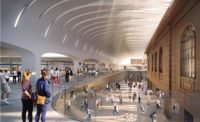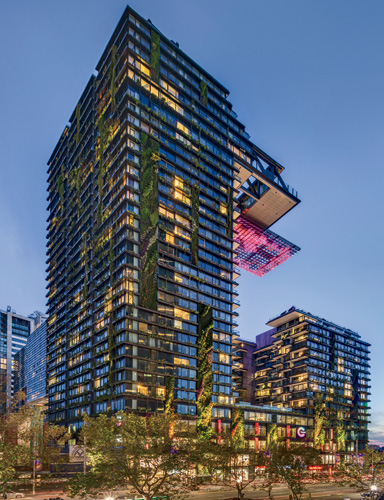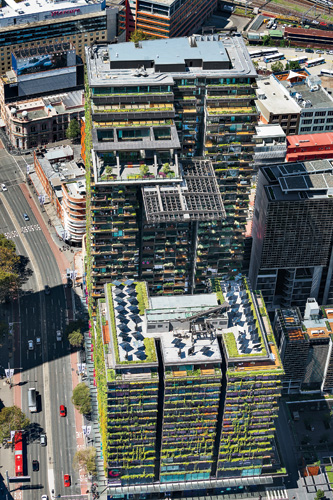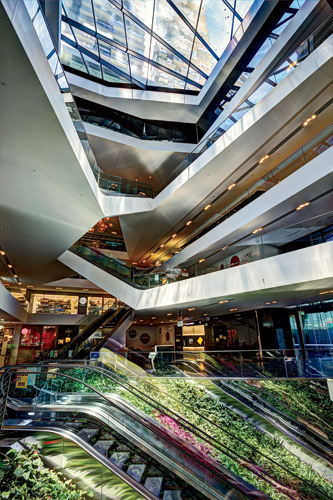One Central Park
With a dramatic cantilever and carefully coordinated sets of mirrors, a design team brings sunlight into a new development in Sydney.














Architects & Firms
Sydney
The most engaging thing about the immense mixed-use development that is Sydney's Central Park, is neither its $1.6 billion price tag nor its role in bringing much-needed pedestrian porosity to a disused industrial site clotting the city's heart. It's not the “best tall building in the world” award, won last year by the main structure, Jean Nouvel's One Central Park; not its investment in resource-conserving strategies such as trigeneration and sewage mining, its $4.9 million public art program, or even its standout features—the world's tallest green wall and a giant cantilevered heliostat—that are now landmarks for miles around.
What is most engaging about Nouvel's building, and the development as a whole, is how these attributes are interwoven to solve many problems—including bringing daylight into a space that otherwise would have been almost always in shade—with a single, essential diagram.
The story goes like this. In 2003, an old brewery that had sprawled ad hoc for almost two centuries over 14 acres adjacent to Central Station came up for grabs. The site's redevelopment was immediately controversial. Arguments raged over height, density, preservation, and environmental protection. The city council was dismissed and reconstituted, competitions held and won, master plans drawn and redrawn, and litigation initiated. World financial markets collapsed, the site changed hands twice, and jurisdiction shifted from city to state government.
It sounds like a recipe for disaster. Yet the resulting development, masterminded throughout by Singapore-based gynecologist-turned-developer Stanley Quek, has charmed even the residents of surrounding low-rise neighborhoods and their representative politicians.
Quek's vision was to encircle the site with buildings, creating a public garden within dense but fine-grained urban fabric. Nouvel's building is the development's first completed project. It comprises two towers—34 and 16 stories—with 623 apartments. The towers rise from a shared three-story podium that includes a pool, restaurants, and a shopping center. The reinforced-concrete frame, enclosed by a glass curtain wall, is shrouded by horizontal planters and climbing plants. Tall for the area, One Central Park's height matches a brutalist university tower (designed by Michael Dysart in 1964) directly across the road. In urban terms, the pair serve as a gateway to the city center, since the road it straddles is the main access to Sydney from the west. But the placement also meant that Central Park's tallest structure would sit on the development's northern boundary.
This move was diplomatic, since it will keep shadows off adjacent neighborhoods. But it was also problematic, because One Central Park would cast a major shadow over its own site—in particular the 69,000-square-foot public garden fundamental to Quek's vision. The solution was the 148-foot cantilever and its heliostat—an apparatus with a movable mirror that reflects sunlight.
The idea was to bounce sunlight into the tower's own shadow, the garden, and into the shopping center's atrium through a water-topped glass roof.
No one was sure it would work, or even really what working might mean. The structure alone—Australia's largest residential cantilever—weighs 120 tons and is supported by a huge triangular truss (which also supports a terrace).
It was the cantilever, as much as the heliostat, that had people worried. Nothing similar had been attempted on this scale. Where heliostats had been deployed, it was mostly small solar energy installations. A large, multi-mirror heliostat for the enhancement of public pleasure was a whole new deal, bringing aesthetic issues into play alongside the strictly technical.
In fact, there are two sets of mirrors: one facing down from the taller building and one facing up from the shorter edifice. The upper, 320-mirror array that is visible to passersby, appears to flutter. This is especially so after dark when, in an installation by light artist Yann Kersal', the mirrors shimmer with many hues. Yet the flutter is illusory. The nighttime display is produced by 2,880 LEDs, mounted nine to a mirror. The mirrors themselves are actually fixed, and therefore make up the secondary, passive element of the device.
The “real” heliostat is the lower, 40-mirror array, says Tim Phillips, design engineer for Kennovations, the heliostat supplier. These lower mirrors, invisible to the general public, track the sun, relying on specially designed software that works from sun-location data. The mirrors, each of which corresponds to a nine-mirror cluster in the upper array, “remember” their position with regard to their target cluster. Sensors beneath the terrace periodically check and recalibrate the software in order to maintain this complex, three-dimensional relationship.
So, does it work? In a word, yes. Sunlight is reflected from the lower array to the upper array and then down to the ground. The mirror material has a reflectivity of about 88 percent—compared with around 93 percent for standard glass mirrors. So, with two sequential reflections, the quantum of sun hitting the ground is between 70 to 80 percent. This is enough to create patches of light on grass, keep plants alive, and cause a perceptible drift among picnickers and other park users. (It is also worth remembering that for almost half the year in Sydney, shadow is to be sought, not avoided).
The building's other defining move, the 1,000-square-meter vertical garden, also generated widespread skepticism. But it seems similarly to be proving its doubters wrong. Here some 38,000 native and exotic plants, selected for their climatic suitability, their toughness, and their aesthetic qualities, have been pocketed and stapled into hydroponically nourished felt-faced panels.
It's a big ask for plants to grow more than 100 meters off the ground in Sydney's gusty and sun-blasted environment. However, the plants, drip-fed by reclaimed black water and nursed by half a dozen full-time gardeners, are thriving, and flowering. (The recycled water, which is highly purified, is also used throughout the development for toilet flushing, landscaping, laundry, heating, and chilling).
Luscious as the vertical planting now is, it still has about 18 months before reaching maturity, says designer Patrick Blanc (who, like Kersal', frequently collaborates with Nouvel). But it's almost spooky how closely early drawings, showing exteriors sculpted in vegetation, have been replicated.
To those who dismiss the living wall as greenwash, Ateliers Jean Nouvel's project architect Bertram Beissel says, “this project was about the visibility of sustainable design.” Otherwise, he argues, strategies like trigeneration and wastewater recycling remain under the radar. But this building has greater significance. It makes sustainability seductive, enchanting, desired. If the design professions had to choose a mission for the future, that should surely be it.
People
Formal name of building:
Location:
Completion Date:
Gross square footage:
Total project cost:
Client:
Owner:
Personnel in architect's firm who should receive special credit:
Design Architect:
Local Collaborating Architect:
Interior designer:
Engineers:
Consultant(s):
Photographer(s):
John Gollings
Murray Fredericks Size: 730,000 square feet Completion Date: January 2014 |
Products
Structural system
Exterior cladding
Roofing
Glazing
Doors
Interior finishes
Lighting
Other unique products that contribute to sustainability: |









